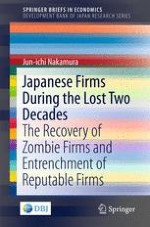2017 | Buch
Über dieses Buch
Why has Japan's lost decade become the lost two decades? This book attempts to provide a novel perspective on causes of stagnant productivity growth of the Japanese corporate sector during the lost two decades. Exploiting the corporate financial dataset compiled by the Development Bank of Japan, it shows empirical evidence that an excessive conservative financial policy of firms in good standing were responsible for sluggish reallocation of productive resources after the recovery of “zombie” firms. The questions taken up in the book include: How can “zombie” firms be properly identified only on the basis of financial data? Why did a majority of “zombie” firms eventually recover? Why did the productivity and profitability of the corporate sector as a whole remain low even after the recovery of “zombie” firms? Why did firms in good standing stick to an excessive conservative financial policy and seem reluctant to invest for innovation? What can be the effective prescription to revitalize these firms in good standing? Supported by both in-depth data analyses and rich anecdotal evidence, this book is highly recommended to readers who seek a convincing and comprehensive explanation of Japan's lost two decades from the financial and corporate behavioral points of view.
Anzeige
